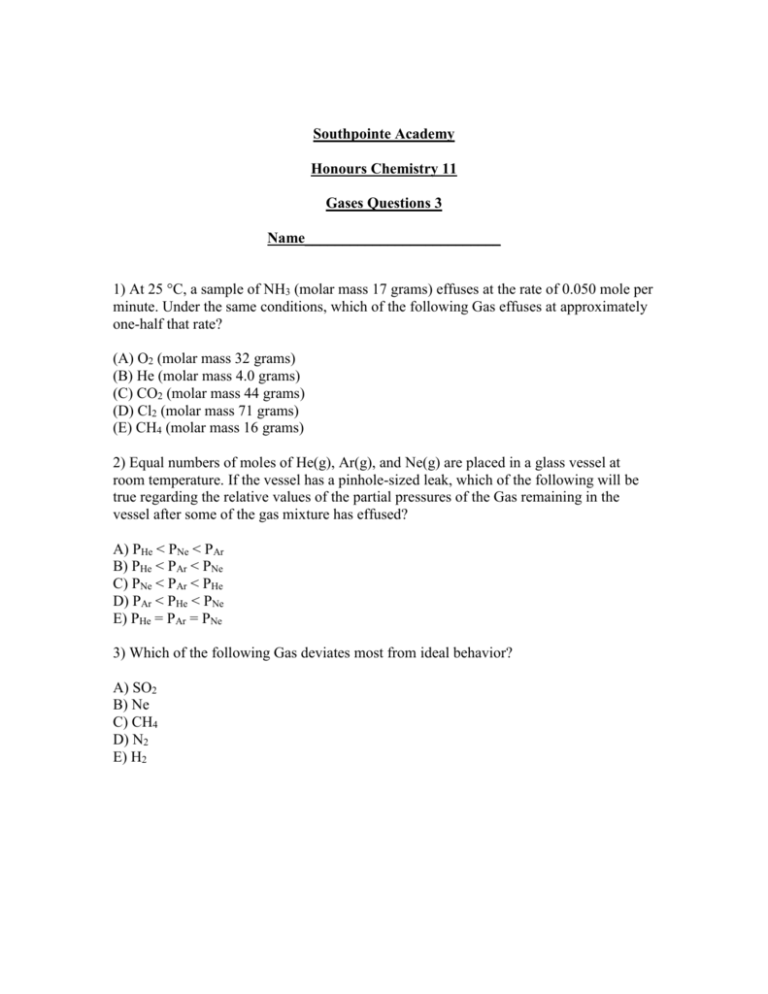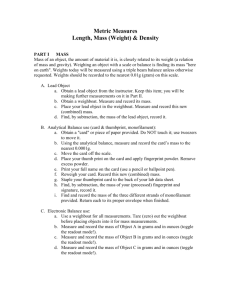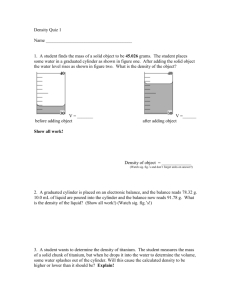Gases Practice Questions 3 - Mr Alasdair Ross at Southpointe
advertisement

Southpointe Academy Honours Chemistry 11 Gases Questions 3 Name__________________________ 1) At 25 °C, a sample of NH3 (molar mass 17 grams) effuses at the rate of 0.050 mole per minute. Under the same conditions, which of the following Gas effuses at approximately one-half that rate? (A) O2 (molar mass 32 grams) (B) He (molar mass 4.0 grams) (C) CO2 (molar mass 44 grams) (D) Cl2 (molar mass 71 grams) (E) CH4 (molar mass 16 grams) 2) Equal numbers of moles of He(g), Ar(g), and Ne(g) are placed in a glass vessel at room temperature. If the vessel has a pinhole-sized leak, which of the following will be true regarding the relative values of the partial pressures of the Gas remaining in the vessel after some of the gas mixture has effused? A) PHe < PNe < PAr B) PHe < PAr < PNe C) PNe < PAr < PHe D) PAr < PHe < PNe E) PHe = PAr = PNe 3) Which of the following Gas deviates most from ideal behavior? A) SO2 B) Ne C) CH4 D) N2 E) H2 4) A hydrocarbon gas with an empirical formula CH2 has a density of 1.88 grams per liter at 0 °C and 1.00 atmosphere. A possible formula for the hydrocarbon is: (A) CH2 (B) C2H4 (C) C3H6 (D) C4H8 (E) C5H10 5) Samples of CO(g) and CO2(g) are placed in 1 L containers at the conditions in the diagram below. (i) Indicate whether the average kinetic energy of the CO2 is greater than, equal to, or less than the average kinetic energy of the CO(g) molecules. Justify your answer. (ii) Indicate whether the speed of the CO2(g) molecules is greater than, equal to or less than the speed of the CO(g) molecules. Justify your answer. (iii) Indicate whether the number of CO2(g) molecules is greater than, equal, or less than the number of CO(g) molecules. Justify your answer. 6) A rigid 5.00 L cylinder contains 24.5 g of N2(g) and 28.0 g of O2(g) (a) Calculate the total pressure, in atm, of the gas mixture in the cylinder at 298 K. (b) The temperature of the gas mixture in the cylinder is decreased to 280 K. Calculate each of the following. (i) The mole fraction of N2(g) in the cylinder. (ii) The partial pressure, in atm, of N2(g) in the cylinder. (c) If the cylinder develops a pinhole-sized leak and some of the gaseous mixture N2 (g ) escapes, would the ratio in the cylinder increase, decrease, or remain the O2 ( g ) same? Justify your answer. A different rigid 5.00 L cylinder contains 0.176 mol of NO(g) at 298 K. A 0.176 mol sample of O2(g) is added to the cylinder, where a reaction occurs to produce NO2(g). (d) Write the balanced equation for the reaction. (e) Calculate the total pressure, in atm, in the cylinder at 298 K after the reaction is complete. 7) and 1.0 atmosphere pressure with the pure gases indicated. (a) Which balloon contains the greatest mass of gas? Explain. (b) Compare the average kinetic energies of the gas molecules in the balloons. Explain. (c) Which balloon contains the gas that would be expected to deviate most from the behavior of an ideal gas? Explain. (d) Twelve hours after being filled, all the balloons have decreased in size. Predict which balloon will be the smallest. Explain your reasoning.








